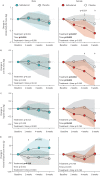Inhaled salbutamol induces leanness in well-trained healthy females but not males during a period of endurance training: a randomised controlled trial
- PMID: 38152086
- PMCID: PMC10752270
- DOI: 10.1183/23120541.00657-2023
Inhaled salbutamol induces leanness in well-trained healthy females but not males during a period of endurance training: a randomised controlled trial
Abstract
Introduction: Many athletes use short-acting inhaled β2-agonists multiple times weekly during training sessions to prevent exercise-induced bronchoconstriction, but it is unclear if treatment impairs training outcomes. Herein, we investigated performance adaptations in well-trained females and males training with prior inhalation of salbutamol.
Methods: 19 females and 21 males with maximal oxygen uptake (V'O2max) of 50.5±3.3 and 57.9±4.9 mL·min-1·kg-1, respectively, participated in this double-blinded, placebo-controlled, parallel-group study. We randomised participants to placebo or salbutamol inhalation (800-1600 µg·training day-1) for 6 weeks of combined endurance (1× per week) and high-intensity interval training (2× per week). We assessed participants' body composition, V'O2max and muscle contractile function, and collected vastus lateralis muscle biopsies.
Results: Salbutamol induced a sex-specific loss of whole-body fat mass (sex×treatment: p=0.048) where only salbutamol-treated females had a fat mass reduction compared to placebo (-0.8 kg at 6 weeks; 95% CI: -0.5 to -1.6; p=0.039). Furthermore, salbutamol-treated females exhibited a repartitioning effect, lowering fat mass while gaining lean mass (p=0.011), which was not apparent for males (p=0.303). Salbutamol negatively impacted V'O2max in both sexes (treatment main effect: p=0.014) due to a blunted increase in V'O2max during the initial 4 weeks of the intervention. Quadriceps contractile strength was impaired in salbutamol-treated females (-39 N·m; 95% CI: -61 to -17; p=0.002) compared to placebo at 6 weeks. Muscle electron transport chain complex I-V abundance increased with salbutamol (treatment main effect: p=0.035), while content of SERCAI, β2-adrenoceptor and desmin remained unchanged.
Conclusion: Inhaled salbutamol appears to be an effective repartitioning agent in females but may impair aerobic and strength-related training outcomes.
Copyright ©The authors 2023.
Conflict of interest statement
Conflicts of interest: The authors have no conflicting interests.
Figures






Similar articles
-
Beta2 -adrenoceptor agonist salbutamol increases protein turnover rates and alters signalling in skeletal muscle after resistance exercise in young men.J Physiol. 2018 Sep;596(17):4121-4139. doi: 10.1113/JP275560. Epub 2018 Jul 30. J Physiol. 2018. PMID: 29968301 Free PMC article. Clinical Trial.
-
Exercise performance after salbutamol inhalation in non-asthmatic, non-athlete individuals: a randomised, controlled, cross-over trial.BMJ Open Sport Exerc Med. 2018 Aug 30;4(1):e000397. doi: 10.1136/bmjsem-2018-000397. eCollection 2018. BMJ Open Sport Exerc Med. 2018. PMID: 30233808 Free PMC article.
-
Inhaled formoterol impairs aerobic exercise capacity in endurance-trained individuals: a randomised controlled trial.ERJ Open Res. 2023 Apr 24;9(2):00643-2022. doi: 10.1183/23120541.00643-2022. eCollection 2023 Mar. ERJ Open Res. 2023. PMID: 37101738 Free PMC article.
-
Inhaled salmeterol: a review of its efficacy in chronic obstructive pulmonary disease.Drugs Aging. 2001;18(6):441-72. doi: 10.2165/00002512-200118060-00006. Drugs Aging. 2001. PMID: 11419918 Review.
-
Do inhaled beta(2)-agonists have an ergogenic potential in non-asthmatic competitive athletes?Sports Med. 2007;37(2):95-102. doi: 10.2165/00007256-200737020-00001. Sports Med. 2007. PMID: 17241101 Review.
References
-
- Arie S. What can we learn from asthma in elite athletes? BMJ 2012; 344: e2556. - PubMed
-
- Hsu E, Bajaj T. Be ta 2 Agonists. In: StatPearls. Treasure Island, StatPearls Publishing, 2020.
LinkOut - more resources
Full Text Sources
Miscellaneous
